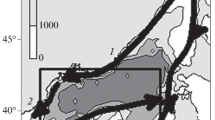Abstract
By tracking the locally strongest part of the sea-surface velocity field, which was obtained by integrating data of satellite altimeters and surface drifting buoys, we extracted the Kuroshio axis south of Japan every 10 days from October 1992 to December 2000. The obtained axes clearly express the effect of the bottom topography; three modes were observed when the Kuroshio ran over the Izu Ridge. The axis was very stable to the south of ‘Tosa-bae,’ off the Kii Channel. Mean current speed at the Kuroshio axis gradually increased from 0.65 m/s south of Kyushu to 1.45 m/s off Enshu-nada.
Similar content being viewed by others
References
Ebuchi, N. and K. Hanawa (2003): Influence of mesoscale eddies on variations of the Kuroshio path south of Japan. J. Oceanogr., 59, 25–36.
Hanawa, K., Y. Yoshikawa and T. Taneda (1996): TOLEXADCP monitoring. Geophys. Res. Lett., 23, 2429–2432.
Imawaki, S., H. Uchida, K. Ichikawa and D. Ambe (2003): Estimating the high-resolution mean sea-surface velocity field by combined use of altimeter and drifter data for geoid model improvement. Space Sci. Rev., 108, 195–204.
Kawabe, M. (1985): Sea level variations at the Izu Islands and typical statable paths of the Kuroshio. J. Oceanogr. Soc. Japan, 41, 307–326.
Kawabe, M. (1995): Variation of current path, velocity, and volume transport of the Kuroshio in relation with the large meander. J. Phys. Oceanogr., 25, 3103–3117.
Kawai, H. (1969): Statistical estimation of isotherms indicative of the Kuroshio axis. Deep-Sea Res., 16, 109–115.
Le Traon, P. Y. and F. Hernandez (1992): Mapping the oceanic mesoscale circulation: Validation of satellite altimetry using surface drifters. J. Atmos. Oceanic Technol., 9, 687–698.
Masuzawa, J. (1969): Note on characteristics of the strongest part of the Kuroshio. J. Oceanogr. Soc. Japan, 25, 259–260 (in Japanese).
Uchida, H. and S. Imawaki (2003): Eulerian mean surface velocity field derived by combing drifter and satellite altimeter data. Geophys. Res. Lett., 30(5), 1229, doi:10.1029/ 2002GL016445.
Umatani, S., M. Kashima, S. Imawaki, H. Ichikawa and M. Fukasawa (2001): Structures and variability of the Kuroshio off Shikoku, Japan revealed by direct current measurements. Reports of Research Institute for Applied Mechanics Kyushu Univ., 121, 103–110 (in Japanese with English abstract).
Yamashiro, T. and M. Kawabe (2002): Variations of the Kuroshio axis south of Kyushu in relation to the large meander of the Kuroshio. J. Oceanogr., 58, 487–503.
Author information
Authors and Affiliations
Rights and permissions
About this article
Cite this article
Ambe, D., Imawaki, S., Uchida, H. et al. Estimating the Kuroshio Axis South of Japan Using Combination of Satellite Altimetry and Drifting Buoys. Journal of Oceanography 60, 375–382 (2004). https://doi.org/10.1023/B:JOCE.0000038343.31468.fe
Issue Date:
DOI: https://doi.org/10.1023/B:JOCE.0000038343.31468.fe




